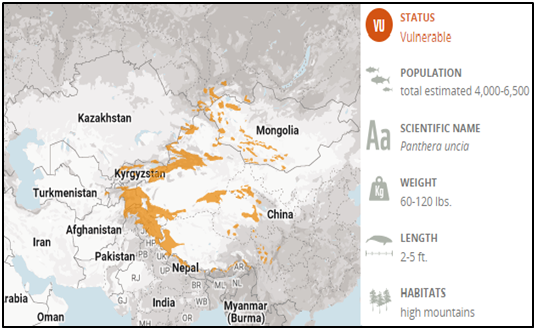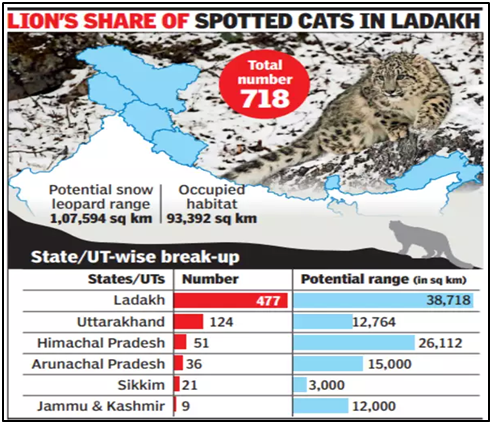Why in News?
- The Union Minister of Environment, Forest and Climate Change released the report on the Status of Snow Leopards in India during the National Board for Wildlife meeting held in New Delhi.
- The report was released as part of the Snow Leopard Population Assessment in India (SPAI) Program, which is the first-ever scientific exercise that reports Snow leopard population of 718 individuals in India.
What’s in Today’s Article?
- About the Snow Leopard
- What is the Snow Leopard Population Assessment in India (SPAI) Program?
- Findings of the SPAI Program
- Significance of the SPAI Program
- Recommendations of the SPAI Program
About the Snow Leopard:

- The snow leopard is a Felidae (mammals in the order Carnivora) in the genus Panthera.
- It is listed as Vulnerable on the IUCN Red List and is native to the mountain ranges of Central and South Asia.
- Globally, snow leopards can be found in 12 countries covering a range of 18 lakh sq km with the largest share in the Tibetan plateau of China, followed by Mongolia and India.
- Other countries include Russia, Afghanistan, Pakistan, Nepal, Bhutan, Kazakhstan, Tajikistan and Uzbekistan.
- In India, snow leopards can be largely found in the high altitude cold, arid and rugged terrains of Jammu & Kashmir, Himachal Pradesh, Uttarakhand, Sikkim and Arunachal Pradesh.
- Snow leopards play a key role as a top predator, an indicator of the health of their high-altitude habitat, and an important indicator of the impacts of climate change on mountain environments.
- If snow leopards thrive, so will countless other species and the largest freshwater reservoirs of the planet.
- However, poaching, habitat loss, declines in natural prey species and retaliatory killings resulting from human-wildlife conflict are the main reasons this big cat is under threat.
- According to the Global Snow Leopard & Ecosystem Protection Programme, the total snow leopard population in the world is roughly estimated at between 4,000 and 6,500.
What is the Snow Leopard Population Assessment in India (SPAI) Program?
- The Wildlife Institute of India (WII) is the National Coordinator for this exercise that was carried out with the support of all snow leopard range states and two conservation partners, the Nature Conservation Foundation, Mysuru and WWF-India.
- The SPAI systematically covered over 70% of the potential snow leopard range in the country and the SPAI exercise was conducted from 2019 to 2023 using a meticulous two-step framework.
- The first step involved evaluating Snow leopard spatial distribution, through an occupancy-based sampling approach in the potential distribution range.
- In the second step, Snow leopard abundance was estimated using camera traps in each identified stratified region.
Findings of the SPAI Program:

- India has an estimated 718 snow leopards in the wild, which are spread over two UTs and four states in the Himalayan Mountain range.
- India may be home to one-sixth to one-ninth of the global population of these 'Ghosts of the Mountains' as these majestic animals are often called because of their incredible natural camouflage.
- The estimated population in different states are as follows: Ladakh (477), Uttarakhand (124), Himachal Pradesh (51), Arunachal Pradesh (36), Sikkim (21), and Jammu and Kashmir (9).
Significance of the SPAI Program:
- Consistent monitoring is essential to ensuring Snow leopards' long-term survival.
- Until recent years, the snow leopard range in India was undefined due to a lack of extensive nationwide assessments for this vulnerable species.
- Recent status surveys have significantly increased understanding, providing preliminary information for 80% of the range, compared to 56% in a previous estimate of 2016.
- The data not only quantifies their numbers but unveils the narrative of coexistence between local communities and snow leopards.
- These regular assessments will offer valuable insights for identifying challenges, addressing threats, and formulating effective conservation strategies.
Recommendations of the SPAI Program:
- It mentions the need for establishing a dedicated Snow Leopard Cell at WII, with a primary focus on
- Long-term population monitoring,
- Supported by well-structured study designs and consistent field surveys.
- States and UTs can consider adopting a periodic population estimation approach (every 4th year) in the Snow leopard range.









